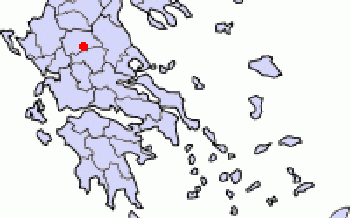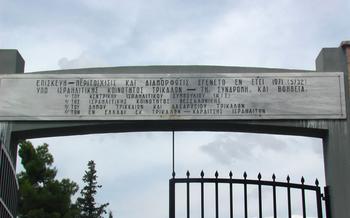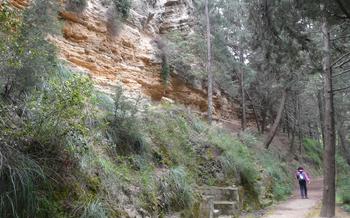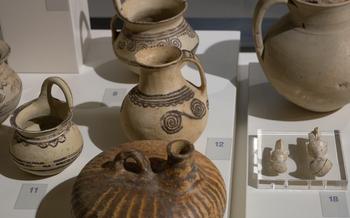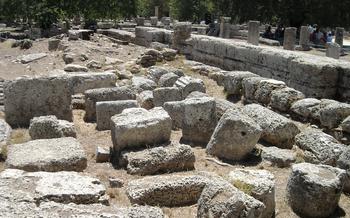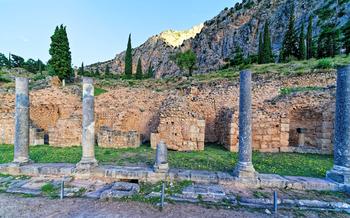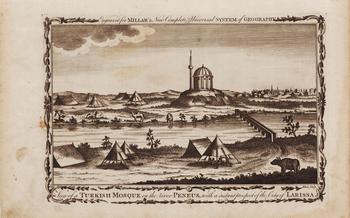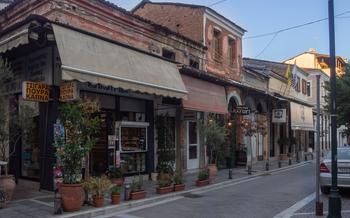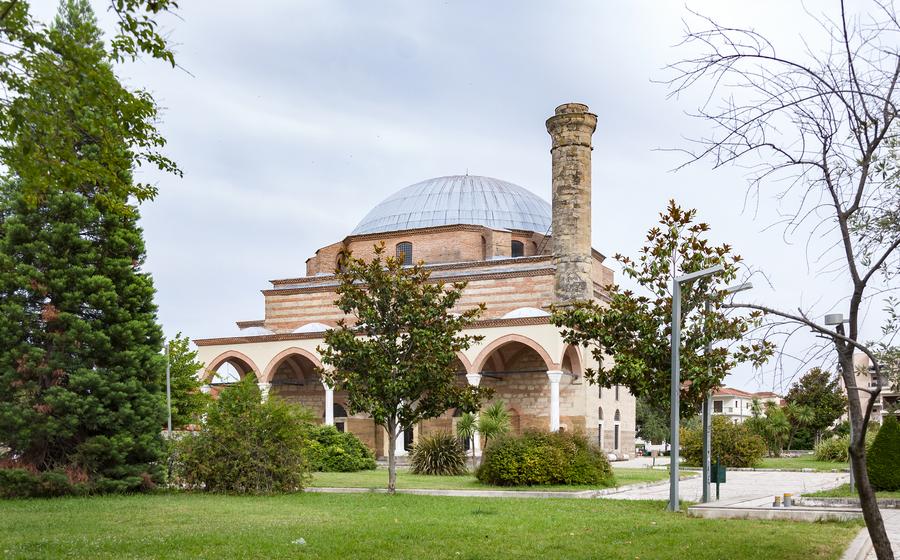
Asclepius of Trikke
- The Antiquity of Asclepius of Trikke
- Location and Accessibility
- Significance of the Site
- History of the Sanctuary
- Medical Practices
- Excavations and Discoveries
- Museum of Asclepius
- Festivals and Events
- Local Cuisine
- Accommodation Options
- Nearby Attractions
- Planning a Visit
- Photography and Social Media
- Insider Tip: Unveiling Hidden Treasures
The Antiquity of Asclepius of Trikke
The Asclepius of Trikke, an ancient sanctuary dedicated to the healing god Asclepius, holds a significant place in Greek mythology and the history of medicine. Asclepius, the son of Apollo and the mortal princess Coronis, was renowned for his exceptional healing abilities and his role as a divine physician. The sanctuary in Trikala was one of the most prominent centers of healing in ancient Greece, attracting pilgrims and patients from across the region.
Asclepius was revered for his ability to cure a wide range of ailments, including physical injuries, chronic diseases, and mental disorders. His healing powers were believed to be derived from his divine heritage and his close association with the god Apollo, who was also associated with healing and prophecy.
The sanctuary of Asclepius in Trikala was closely intertwined with the city's identity. Trikala, known in antiquity as Trikke, was a prosperous and influential city in the region of Thessaly. The sanctuary's presence contributed to Trikala's reputation as a center of healing and learning, attracting visitors from far and wide.
Location and Accessibility
Asclepius of Trikke is situated on a hilltop overlooking the city of Trikala, in central Greece. The exact address is Asclepius of Trikke, Trikala 421 00, Greece. Reaching the site is relatively easy, whether by car or public transportation. For those driving, follow the signs from the city center to the Asclepius of Trikke Archaeological Site. There is ample parking space available near the entrance.
For those relying on public transportation, take a bus from Trikala's central bus station to the Asclepius of Trikke stop. From there, it's a short walk to the entrance of the archaeological site. The site is generally accessible for people with disabilities, with paved pathways and ramps leading to the main structures. However, it's advisable to contact the site's administration in advance for any specific accessibility needs or assistance.
Significance of the Site
Asclepius of Trikke stands as a testament to the ancient Greeks' advanced understanding of medicine and healing practices. The site's unique and well-preserved nature offers a rare glimpse into the world of ancient Greek healthcare. Archaeological discoveries at the sanctuary, including inscriptions, medical instruments, and votive offerings, have shed light on the treatments and therapies offered to patients who sought healing at the sanctuary. These discoveries have provided valuable insights into the medical knowledge and practices of the ancient Greeks, contributing to our understanding of the history of medicine.
Additionally, the sanctuary's significance extends beyond its medical aspects. It served as a religious and cultural center, where people from all walks of life came to seek healing and pay homage to Asclepius, the god of healing. The sanctuary's well-preserved structures, including the temple, stoa, and baths, offer a glimpse into the architectural and artistic achievements of the ancient Greeks. The site's rich history and cultural significance make it a valuable asset for understanding the ancient Greek civilization.
History of the Sanctuary
The origins of the Asclepius of Trikke sanctuary are shrouded in mystery, with various theories and legends attempting to explain its establishment. One popular myth suggests that Asclepius himself, the renowned healing god, visited Trikke and founded the sanctuary as a place of healing and rejuvenation. Another theory attributes its creation to the Thessalian king Echemon, who sought divine intervention for his ailing son.
The sanctuary's reputation as a healing center grew rapidly, attracting pilgrims and المرضى from across the ancient world. It became a place where people could seek solace and relief from their ailments, placing their trust in the healing powers of Asclepius and his priests.
Over time, the sanctuary underwent several expansions and renovations, reflecting its growing importance and popularity. New structures were added, including a larger temple, a stoa (covered walkway), and baths, to accommodate the increasing number of visitors. The sanctuary also became a center of medical knowledge and learning, with priests and healers sharing their expertise and developing new treatments.
However, the sanctuary's prosperity did not last forever. In the 4th century AD, it suffered a devastating blow when a powerful earthquake struck the region, causing significant damage to the structures. While the sanctuary was partially restored, it never regained its former glory. With the rise of Christianity and the decline of ancient Greek religious practices, the sanctuary eventually fell into disuse and was abandoned.
Medical Practices
The Asclepion of Trikke was not just a religious site but also a center of medical knowledge and healing practices. The priests and healers who served at the sanctuary were skilled in various medical treatments and therapies, including herbal remedies, surgery, and physical therapy.
The sanctuary's medical practices were closely intertwined with religious rituals. Patients would often make offerings to Asclepius and other deities, seeking their favor and guidance in their healing journey. The priests would then interpret the signs and omens from these offerings to determine the appropriate course of treatment.
Sacred rituals played a vital role in the healing process. Patients would participate in purification ceremonies, make sacrifices, and offer prayers to Asclepius. These rituals were believed to create a sacred space conducive to healing and to invoke the divine power of Asclepius.
Excavations and Discoveries
Archaeological excavations at the Asclepius of Trikke sanctuary began in the late 19th century and have continued intermittently ever since. These excavations have unearthed a wealth of artifacts and information that have shed light on the site's history and function.
Among the most significant discoveries are numerous inscriptions, which provide valuable insights into the sanctuary's religious practices and the types of medical treatments offered. Statues and other votive offerings dedicated to Asclepius and other deities have also been found, attesting to the sanctuary's popularity and the faith that people had in its healing powers.
Perhaps the most exciting discovery was a set of medical instruments, including scalpels, forceps, and probes. These instruments provide direct evidence of the medical practices that were carried out at the sanctuary and offer a glimpse into the sophisticated medical knowledge of the ancient Greeks.
The excavations at Asclepius of Trikke have been instrumental in our understanding of ancient Greek healing practices and have helped to shed light on the important role that this sanctuary played in the religious and medical life of ancient Greece.
Museum of Asclepius
Within the city of Trikala, a short distance from the archaeological site of Asclepius, the homonymous museum is located. This modern and well-organized museum houses a rich collection of artifacts and exhibits related to the sanctuary and its history.
Visitors can explore galleries dedicated to the history of the sanctuary, its architecture, medical practices, and the religious significance of Asclepius. Among the highlights of the collection are inscriptions detailing medical treatments, statues of Asclepius and other deities, and a variety of medical instruments used by the ancient healers.
The museum also features interactive displays and multimedia presentations that bring the site's history to life. Visitors can learn about the different types of medical treatments offered at the sanctuary, the role of priests and healers, and the use of sacred rituals and offerings in the healing process.
The Museum of Asclepius is an essential stop for anyone interested in the history of medicine and the ancient Greek healing practices. It provides a comprehensive overview of the sanctuary and its significance, and offers a deeper understanding of the medical knowledge and practices of the ancient world.
Festivals and Events
The Asclepius of Trikke sanctuary is not just a historical site; it is also a place where local traditions and culture are kept alive. Throughout the year, various festivals and events are held at or near the sanctuary, attracting both locals and tourists.
One of the most significant events is the annual Asclepius Festival, held in July or August. This festival celebrates the healing god Asclepius and features traditional music, dance, and reenactments of ancient rituals. Visitors can witness processions, theatrical performances, and offerings made to the god, providing a glimpse into the religious practices of ancient Greece.
Another popular event is the Trikala Food Festival, held in September. This festival showcases the culinary delights of the Trikala region, with vendors offering a variety of traditional dishes, street food, and local delicacies. Visitors can savor the flavors of Trikala's rich gastronomy, from savory pies and grilled meats to sweet pastries and fresh produce.
These festivals and events offer a unique opportunity for visitors to experience the vibrant local culture and traditions of Trikala. By participating in or witnessing these events, visitors can gain a deeper understanding of the region's history and heritage while immersing themselves in the lively atmosphere of Greek festivities.
Local Cuisine
Trikala is renowned for its rich culinary traditions, deeply rooted in the fertile plains and diverse agricultural heritage of the region. When visiting the Asclepius of Trikke sanctuary, take the opportunity to savor the local delicacies that reflect the essence of Thessalian cuisine. Indulge in the fragrant "tiropita", a savory cheese pie crafted with flaky filo pastry and filled with a blend of local cheeses. Sample the hearty "spanakopita", a spinach and feta-filled pie that bursts with flavor.
For a taste of traditional meat dishes, try the succulent "souvlaki", grilled skewers of marinated meats, or the slow-cooked "kleftiko", tender lamb roasted in a wood-fired oven. Vegetarians will delight in the vibrant "gemista", a medley of stuffed vegetables such as tomatoes, peppers, and zucchini, brimming with aromatic rice, herbs, and spices.
Pair your meal with a glass of "tsipouro", a local anise-flavored spirit, or a refreshing glass of wine from the nearby vineyards. End your culinary journey with a sweet treat, such as the syrupy "loukoumades", golden-fried dough balls soaked in honey and sprinkled with cinnamon, or the delicate "galaktoboureko", a custard-filled pastry topped with crispy filo.
Exploring the local cuisine of Trikala is an integral part of experiencing the region's cultural heritage. Embrace the opportunity to savor the authentic flavors and aromas that have been passed down through generations, creating a tapestry of culinary delights that will linger in your memory long after your visit.
Accommodation Options
Trikala offers a wide range of accommodation options to suit every traveler's budget and preferences. From budget-friendly hostels and guesthouses to luxurious hotels with modern amenities, there's something for everyone. Many hotels and guesthouses are conveniently located within walking distance of the Asclepius of Trikke sanctuary, allowing visitors to easily explore the site and the surrounding area. When choosing a place to stay, consider factors such as location, amenities, and price to find the best accommodation for your needs. To secure the best deals, it's advisable to book your accommodation in advance, especially during the peak tourist season. With careful planning, you can find a comfortable and convenient place to stay that will enhance your overall experience in Trikala.
Nearby Attractions
Trikala is not only home to the renowned Asclepius of Trikke, but also offers a wealth of other captivating historical and natural attractions. History buffs will be enthralled by the city's well-preserved Ottoman architecture, including the iconic stone bridge over the Lithaios River. Nature enthusiasts, on the other hand, will find solace in the lush Trikala Park, a sprawling green oasis adorned with gardens, playgrounds, and a tranquil lake.
To truly immerse yourself in the region's rich cultural heritage, consider embarking on a day trip to the nearby Meteora. This awe-inspiring complex of Eastern Orthodox monasteries, perched atop towering rock formations, is a UNESCO World Heritage Site and an architectural marvel. The monasteries offer breathtaking views of the surrounding landscape and provide a glimpse into the ascetic lifestyle of the monks who once resided there.
Planning your itinerary is essential for making the most of your time in Trikala. To explore the city's historical and cultural gems, allocate at least a day for leisurely strolls through the old town, admiring its Ottoman architecture and visiting the local museums. If you're a nature lover, set aside a morning or afternoon to rejuvenate in the serene Trikala Park. And to witness the architectural wonders of Meteora, plan a full-day excursion, allowing ample time to explore the monasteries, soak in the panoramic views, and delve into their fascinating history.
Transportation options are readily available to facilitate your exploration of Trikala and its surroundings. Local buses provide convenient and affordable connections between the city center and nearby attractions, including Trikala Park. For a more immersive experience, consider renting a car, which offers the flexibility to explore at your own pace and venture further afield to hidden gems off the beaten path.
Planning a Visit
Best time to visit: The best time to visit the Asclepius of Trikke is during the shoulder months (April-May and September-October) when the weather is pleasant, and the crowds are smaller. The summer months (June-August) can be hot and crowded, while the winter months (November-March) can be cold and rainy.
Duration of visit: Plan to spend at least 2-3 hours exploring the Asclepius of Trikke. This will give you enough time to see the main attractions, such as the temple, the stoa, and the baths, and to learn about the history and significance of the site.
Tips for a great visit:
-
Book a guided tour: A guided tour is a great way to learn more about the history and significance of the Asclepius of Trikke. Tours are available in several languages and can be booked in advance or on-site.
-
Explore at your own pace: If you prefer to explore at your own pace, you can purchase a ticket at the entrance and wander around the site on your own. There are information panels throughout the site that provide information about the different structures and their functions.
-
Bring comfortable shoes: The Asclepius of Trikke is a large site, and you will be doing a lot of walking. Make sure to wear comfortable shoes so that you can fully enjoy your visit.
Photography and Social Media
As you explore the Asclepius of Trikke, photography is a fantastic way to capture the site's beauty and historical significance. Please be respectful of the site's sacred nature and avoid using flash or disturbing other visitors. To capture the best shots, visit during the golden hours of sunrise or sunset when the light is soft and warm. Experiment with different angles and perspectives to showcase the unique features of the ruins and the surrounding landscapes.
Share your experiences on social media to help promote the site and its preservation. Use relevant hashtags and tag the official accounts of the site or the local tourism board to reach a wider audience. By sharing your photos and stories, you can help raise awareness about this incredible ancient site and encourage others to visit and appreciate its historical significance.
Insider Tip: Unveiling Hidden Treasures
As you explore the Asclepius of Trikke sanctuary, keep an eye out for hidden gems that often go unnoticed by the casual visitor. Venture beyond the main temple and stoa to discover a secluded courtyard, where a serene fountain once stood, surrounded by ancient trees that have witnessed centuries of healing rituals. This tranquil spot invites you to pause, reflect, and connect with the sanctuary's sacred atmosphere.
To escape the crowds and find moments of peace, seek out the lesser-known paths that lead to the sanctuary's periphery. Here, among the ruins of ancient structures, you can immerse yourself in the site's history and feel a deeper connection to its healing energy. Embrace the tranquility of these hidden corners and let the sanctuary's magic work its wonders on your mind, body, and soul.
Before your visit, take the time to learn about local customs and traditions related to the sanctuary. Show respect by dressing modestly and behaving appropriately within the sacred grounds. Engage with the locals, who are proud to share stories and insights about the site's significance. By embracing local customs, you'll not only enhance your experience but also contribute to preserving the sanctuary's cultural heritage.
